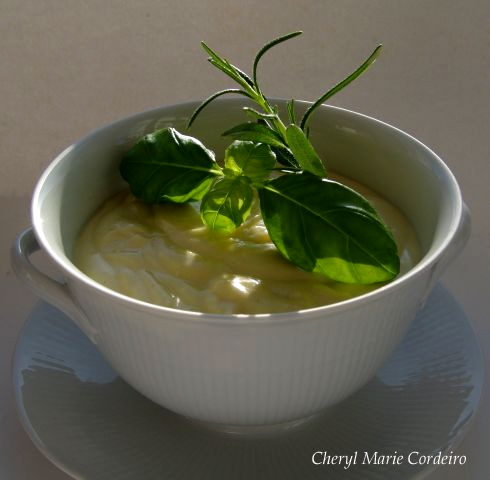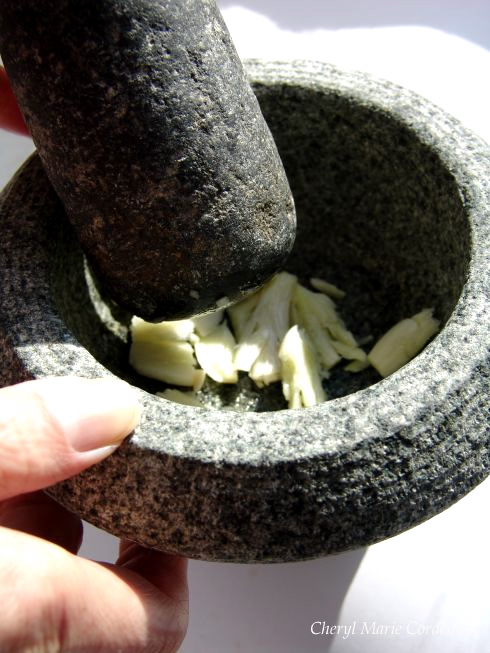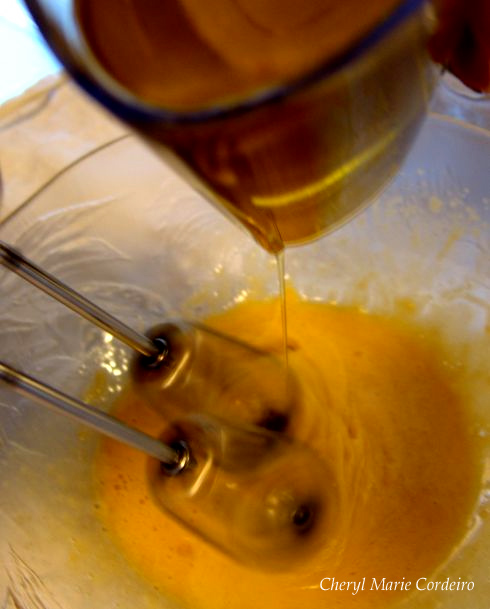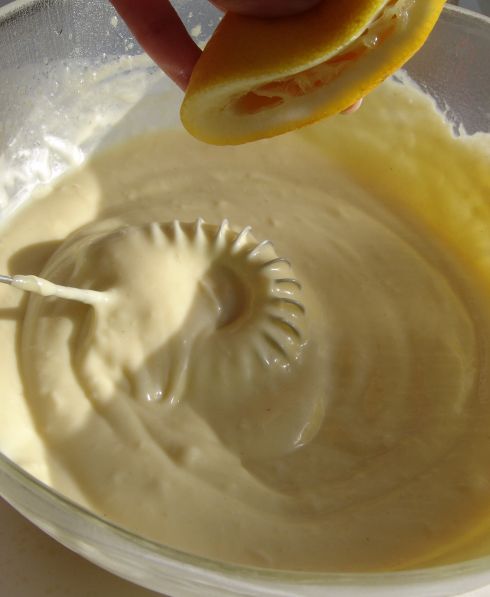
A mild aïoli made entirely with natural ingredients,
topped with fresh rosemary and some basil
Photo © J E Nilsson for CMC, 2009
I grew up in Singapore with the assumption that good cooking based on fresh and natural ingredients was something that would never change. I assumed that there would always be someone there who took fresh fruits and newly harvested vegetables, flipping fishes, and fresh meat into their pots and pans to serve well cooked dishes at affordable prices.
The hawker centre concept in Singapore to me was equivalent to well-made home cooked food at very modest prices. For perhaps $1-2 USD you could sit down at a table and have a dish that would have taken hours of preparation to make yourself. Granted, the table was not your own and sometimes a bit wobbly and more often than not you would be seated outdoors, but that was a small price to pay compared to the returns of a local delicacy from the hands of someone who loved doing what they knew best.
Even simple things such as your daily coffee and tea from a coffee shop in Singapore rivals the choices of the mega coffee chain Starbucks, coming in a variety of servings such as kopi, kopi-O, kopi-si etc and teh, teh-O, teh-si, teh tarik etc. This philosophy and lifestyle towards affordable food made with fresh raw ingredients and a passion for a select dish, reflects what I think is quality of life in a modest setting.
Today however, Singapore is seeing the commercialisation and franchising of the hawker centre concept, Food Republic is one such concept where recipes are standardized and foods pre-processed before serving. It’s a concept that is a far cry from the traditional food hawkers I grew up with, even though they equip the interior of these franchise outlets with old style kopitiam (breakfast coffee house) furniture and tea cups. These days, the real food hawkers’ fare can be found in for example, Bangkok, Thailand where food hawkers cook along the streets right next to the wet markets.
The world of food as I knew it has changed, and the gap between authentic and pre-processed foods served whilst eating out in Singapore is widening.
In those countries where small family owned restaurants are still cooking simple but well made food, prepared “from the ground up”, the food served remain good or bad after what the powers to be – and the family recipes – allows. Still however, with its inner basic quality of being what it looks like, authentic. But as more and more industrial pre-fab food products makes its way into our daily diet, comes a lowering of nutritional values and as I see it, a lowering of the quality of life.
To have a passionate relation to food is an everyday luxury that most anyone can afford. It is also not a question on how much money you have; it’s about what you get for it. Personally I eat fast foods such as burgers and pizzas quite often, and I don’t mind that. What I do see however is that a fast food outlet burger is a sad meal compared to what you might whip up yourself in your home, at a lesser cost.
One of my life’s best food experiences was eating a sun-ripened mango I bought at Stanley Market in Hong Kong that cost me almost nothing.
The change is visible to anyone outside the kitchens in small details such as homemade iced-lemon tea. As late as a few years ago almost all iced-lemon tea was home made at the restaurants in Singapore. It was what you got, without asking. You had your favourite places that made the best, and a few places that you put up with, but they all made their own. Today you will be handed a can. And if you look at the label, it will say that it contains artificial flavours. This never fails to stun me silent. How cheap can the food industry get – artificial tea?
The apparent change is that the food industry is moving their position forward, as they are taking over more and more of the food preparation phase. The disadvantage is the degradation of the raw materials used, since it is designed and chosen after what fits the agenda of the industry best. It worries me that the technical properties such as product shelf life are prioritised before flavour, content and nutritional values.
As an example of how easy it is to make seemingly complicated products yourself better and cheaper at the same time, I would like to suggest this mild garlic flavoured mayonnaise or aïoli. It would have been equally simple to end up with a plain mayonnaise by just leaving out the garlic, but while the hard-core aïoli enthusiasts will never stop arguing about the difference which – besides the garlic – is founded more on the patriotic or emotional plane, I will stick with this being a mild aïoli.
The ingredients to an aïoli are garlic, mustard, eggs and oil.

A few cloves of garlic in a stone pounder.
Pound the cloves to a watery pulp before adding into the egg yolks. It is easy to think that using a stone mortar and pestle like this is just because it is fun or looks fancy but as far as I can tell it is a huge difference in the flavour of any onion or garlic cloves that is actually pounded rather than crushed, chopped or cut. The Nyonyas have always pounded their rumpah (mix of spices and base to most dishes they cook), and no blender can match the consistency and flavour they get by that.

A mixture of olive oil and vegetable oil.
For this aïoli, mix 3 parts of vegetable oil with 1 part virgin olive oil, all in all 400 ml (14 oz). This amount is not critical; within limits you can use as much oil as you want.

Our blended oil is being whisked into the egg yolks.
Mix two egg yolks with one tbs of mustard and one large crushed garlic clove. Add the oil in a slow stream. It is critically important that the egg finds time to absorb the oil before you pour more. If the oil droplets become too large, the emulsion might “break”. If this happens, start off with a new yolk in a new bowl and add the broken mix and remaining oil – drop by drop – to the new yolk.

Add lemon juice to the mixture.
Add about the one tbs of lemon juice or some nice flavoured vinegar and as a last measure, add about one tsp of crushed sea salt plus some crushed white pepper to your liking. Taste it and adjust spices accordingly.
It’s a splendid soft sauce or dressing that goes well with anything you would consider eating with oil, egg yolks and a drop of mustard. How about barbecued meat, fried fish, and seafood? Maybe spreading on bread instead of butter, with some lettuce, with lemons and some salt and pepper?
In a fridge this will keep as long as any factory made mayonnaise. Personally I am planning to have this aïoli with a fresh shrimp sandwich of epic proportions!